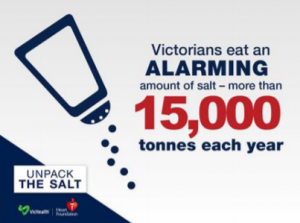Time to shake the salt out of the Australian diet
March 15, 2018
Salt: a white crystalline substance rich in stories connected to culture, traditions, historical events and health. Ancient Egyptians used salt to preserve mummies. Japanese sumo wrestlers throw salt into the ring before fighting to ward off evil spirits. Mahatma Gandhi led the famous salt march across India in protest of exorbitant salt taxes imposed by the then British rulers. But more recently salt has been in the spotlight due to concerns of excess salt in our diet.
Unpack the Salt is a current consumer awareness campaign led by the Heart Foundation and VicHealth. The campaign seeks to raise awareness of high salt intakes within the community and promote action for change to reduce the amount of salt in the Victorian diet to protect cardiovascular health.
Senior Lecturer in Population Nutrition Dr Carley Grimes offers a perspective on this topic.

Image source: Heart Foundation
Why do we care about too much salt in our diet?
In a nutshell, eating too much salt can raise blood pressure in adults as well as in children. High blood pressure is a major risk factor for heart attack and stroke, both of which are costly and deadly health problems facing Australia. As most of the population will go on to have high blood pressure in older age, there has never been a better time to intervene than in early life to help protect blood pressure levels from the get go. Additional concerns related to excess salt in the diet include links with obesity and the promotion of taste preferences that favour saltier foods.
Could you be eating too much salt? How much is too much?
Health organisations recommend that adults eat no more than 5 grams of salt per day, which is about a teaspoon of salt. Children need even less and recommendations are age dependent. For example a child aged 4-8 years should have no more than 3 ½ grams of salt per day.
Our own research on Victorian’s attitudes to salt intake, conducted at the Institute for Physical of Activity and Nutrition shows that while most adults (84%) believed that Australians eat too much salt, less than a third (28%) believed their own individual salt intake exceeded dietary recommendations. In other words, people know that eating too much salt is a problem for the community but perhaps it’s not their own problem. However, the stark reality is that on average Adults eat about 9 grams of salt per day. With regards to schoolchildren, we recently reported intakes of about 6 grams per day and found that 7 out of 10 children exceeded dietary recommendations for salt.
Underestimating your own salt intake is probably an easy mistake given that most (75%) of the salt we eat each day comes from packaged foods, hiding away in products such as bread, cheese and pasta/Indian simmer sauces. Of course some of the more suspected ‘salty’ culprits such as bacon and processed meats; and take-away foods like pizza and burgers also add salt to our diet. Chances are if you eat any packaged foods you’re probably getting too much of the white stuff.
The evidence linking high salt intakes to adverse cardiovascular health is extensive and robust. In response numerous leading health organisations around the world are stepping up action on population salt reduction. The World Health Organization has identified salt reduction as a key target to reduce non-communicable disease and has set a global target for a 30% relative reduction in mean population intake of salt by 2025. The Australian government has signed up to this target, meaning it’s time for action. Victoria is leading the way. In 2015 VicHealth established a Salt Reduction Partnership Group and the group has mapped out an action plan for salt reduction in Victoria. The Heart Foundation’s Unpack the Salt campaign is part of this initiative.
So what can you do to cut back on salt?
- Check the food label. There is a lot of variation in the amount of salt found in foods on supermarket shelves. Take pasta sauces for example dependent on the brand some types can have 90 x more salt. Check the nutrition information panel to compare the salt (sodium) content of similar products and pick one with less sodium per 100 grams.
- Eat fresh. Aim to follow the Australian Dietary Guidelines and include plenty of fresh vegetables and fruit which are naturally low in salt. There’s no problem with buying frozen or canned vegetables, just make sure you get the ‘no added salt’ variety. Swap salty processed meats for lean meats and poultry or fish or eggs.
- Throw the salt shaker out. Don’t add salt to your food at the table and when cooking try experimenting with alternative flavourers, such as herbs and spices. When we start to eat less salt, over time our taste preferences adjust, meaning we can get the same flavour kick but with less salt.
- Food manufacturers make foods that consumers buy. So speak with your wallet, buy products that are labelled as ‘salt reduced’ or ‘no added salt’. Support the manufacture of foods with less salt. When the amount of salt added to foods is gradually reduced it can go undetected by our taste buds.
Dr Carley Grimes
Senior Lecturer in Population Nutrition
Institute for Physical Activity and Nutrition (IPAN), Deakin University